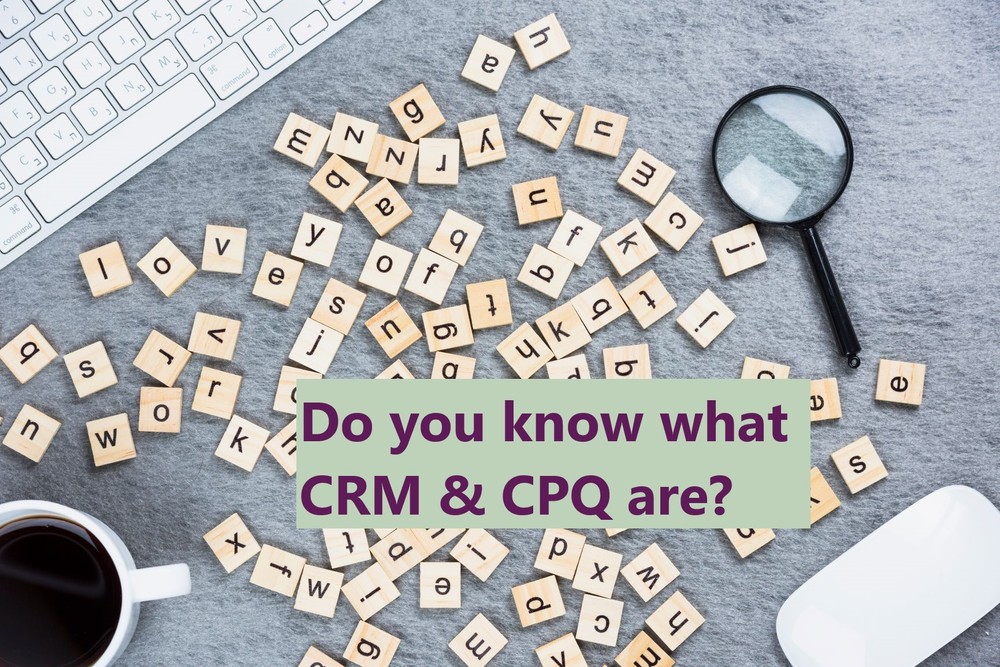In case you missed the first post (CAD & PLM) you can read it here.
Acronyms are meant to simplify things. However, every day there seem to be new ones popping up. Nowhere is this truer than in software, especially in manufacturing software.
Manufacturing software is a domain where acronyms are everywhere. The recent developments in new software solutions have multiplied the number of acronyms that are used daily. For example; a few years ago, the terms “CPQ” was still uncommon among large manufacturers. Today, “CPQ” has become indispensable for large manufacturers’ growth strategy.
Whether you are new to manufacturing, sales (or both), or you are simply having trouble keeping up with all the different types of software solutions available, we’ve created this series of posts to help get familiar with the lingo.
CRM – (Customer Relationship Management)
Focus area: Customer
What it is?
CRM software help customer-facing teams manage all their interactions with clients and sales prospects. CRM can serve as the communication hub, where phone calls, emails, and meetings are mapped out to get an overview of the various engagements the organization had with a particular customer.
CRMs also synchronize with other business processes platforms, to monitor and track marketing, sales, and customer success activities. These platforms also allow executives and sales managers to get an overview of their teams’ performance.
Its role in the Sales Process:
CRM is a salesperson’s homepage. It’s where all their activities are (hopefully) clearly laid out. This is where all the information regarding their leads, prospects, and customer is gathered and analyzed. From there sales teams can plan, execute and record their activities and results.
Many large CRM platforms have built-in tools that track the progress of leads on their journey towards becoming clients, acting as a guide for the user to take the next steps. CRM can also integrate with CPQ (see more below) to keep track of the various products and quotations submitted to the customer.
CRMs can also ensure continuity beyond the sales process. This is the case a customer moves from inside-sales (prospect) to account managers, to later customer success. Each new user will be able to have a historical picture of that customer’s journey.
CPQ – (Configure Price Quote)
Focus Area: Customer
What it is?
In simple terms, CPQ stands for Configure, Price, [and] Quote. It is primarily a software tool that empowers sales teams to confidently and accurately create complete quotes from end to end. The most powerful CPQ integrates seamlessly to other software platforms, mainly your CRM and ERP systems (don’t worry this will make sense soon).
The right CPQ ensures that the products are configured to the specific requirements of the customer while still ensuring that the product configured is within the product’s constraints. In other words, CPQ allows for salespeople to configure a complex product without having to manually perform all the calculations and engineering work that will ensure a viable product.
Once configured, this software can price for that specific configuration by integrating factors like exchange rates, product availability, discounted pricing, etc.
Finally, CPQ combines all this information and generates the documents required to submit a complete and detailed quote.
Its role in the Sales Process:
As just explained, CPQ is present throughout the entire sales process. The best CPQs can integrate into the CRM platform, allowing the salesperson to track the various quotes presented to the customer. CPQ can even play a role in selling after-sales services, by quoting for future maintenance, lifecycle costs, etc.; however, I am getting a bit ahead of myself here.
In case you missed the first post (CAD & PLM) you can read it here.
For our next issue, we will define ERP and PDM.


